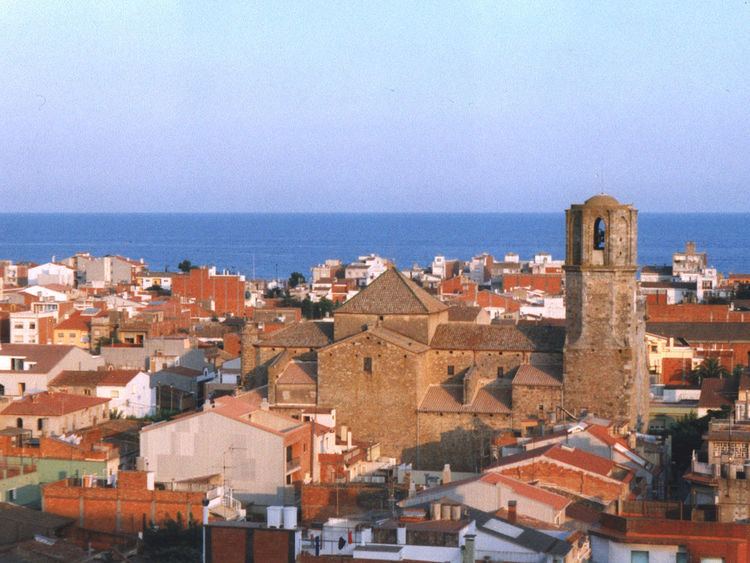Malgrat de Mar is a municipality in the comarca of the Maresme, in the province of Barcelona, Catalonia, Spain. It is situated on the coast between Santa Susanna and Blanes. A local road runs from the town to the main N-II road, while the B-682 connects it with Blanes, Lloret de Mar and Tossa de Mar. It is served by a RENFE railway station on the line between Barcelona and Maçanet-Massanes.
The town is located 4 meters above sea level. It has a coastal-Mediterranean climate, with smoothed temperatures almost over the whole year. The annual precipitation amount averaged over the last 18 years is about 650 mm.
Malgrat de Mar was first populated between the 13th and 14th centuries, when it was known as Vilanova de Palafolls. However, it is known that the early inhabitants of Malgrat built their houses on the hill (named "El Castell") that is located in the middle of the town.
Traditionally, Malgrat has been predominantly an agricultural town with considerable maritime commercial activity and, since the 19th Century, an important industrial centre. The tourist activity started in Malgrat de Mar around 1960. And since then it has become an important touristic destination.
Main sights
Church of St Nicolau. Built on 16th century and enlarged in the 18th century. Because of its size, it is known as the Cathedral of the Coast.Peixateries velles (The old fish market). On the south side there were the meat market, while on the North side there were the fish market. On this later side, the stone-made waiter where the fish was sold is still conserved.Town hall. A Modernist style building, which was inaugurated on 15 August 1913.La Cooperativa (The Cooperative - The library). One of the oldest buildings in Malgrat, built by the Clapers family in the 16th century. Later, it was a blood hospital (18th century), the Casino Malgratenc (a cultural society) on the 19th century, and a worker's cooperative on the 20th century. Finally, it has become the library in the 21st century.Ca l'Arnau. A Modernist style building, built on 1914. Recently, it had been renewed and it has become the Music School.The Old Hospital. In 1441, Hug Descolomer founded this hospital to help the poor people. Nowadays it has become a therapeutic center, and its chapel is used as an exhibition galleryEl castell. It is a tower located on the top of the hill, just in the center of the town. It is surrounded by a park, and it can be accessed by the Hug Descolomer road, totally constituted by steps, next to the Passatge dels Arcs (Arches passage). The park offers a panoramical view of Malgrat and its surrounding areas.Torre d'en Riera (also called Torre de la Vídua de Can Sala). It's a Modernist style house.Parc de Can Campassol. It is a park located in Carrer de Mar street. It housed a colonial style house where Zenobia Camprubí was born (the wife of Juan Ramón Jiménez, Nobel Award of Literature, 1956). In the artificial lake of the park there is a sculpture of her.La Pilona. It is an artificial island located in the middle of the sea. In the 1910s, it was used to load ships with mineral extracted from the mines of Can Palomeres, in the mountains located in the North of Malgrat. There was an aerial structure to transport the mineral from the mines towards the platform. Today is home to many shags.Torre de l'Esquena. It is a 19th-century house.Plaça de Marià Cubí. It is a square inaugurated on 1956. The sculpture is dedicated to Marià Cubí i Soler, born in Malgrat on 1801, who became a frenologist and linguist.Natural places and parks
Pla de Pineda. Located behind the hotels in Passeig Marítim. This space has conserved the agriculture in spite of the hard urbanistic pressure. It is very pleasant to take a walk around this placePla de Grau. Located at the east of the town, between Malgrat and the Tordera river. It is the greatest agricultural space in Malgrat. Produce include the fesols del ganxet (a variety of white beans). This space has been protected.Mouth of the Tordera. Usually, the Tordera river is dry in many parts of its course, but there is a lake in its mouth. There can be found a lot of bird species.Parc Francesc Macià. The newest and biggest park in Malgrat, home to fantastic figures inspired by children tales.L'Astillero. Located opposite to the tourist hotel zone.Central beach. Located In front of downtown Malgrat.Tordera Mouth beach. The largest beach in Malgrat. It extends from Malgrat downtown to the Tordera mouth. There is a nudist zone. Cárdenas, Nicaragua Incisa in Val d'Arno, Italy Moguer, Spain Seynod, France
